Abstract
The intestinal mucosa is a rapidly proliferative tissue, with a highly dynamic cell population. Its total cellular mass is well controlled and can adapt, with hypo- or hyperplasia, to a wide variety of stimuli. Luminal nutrients, hormonal factors, and pancreatic and biliary secretions have all been implicated in the regulation of intestinal mucosal adaptation. Similarly, the same factors appear essential for the maintenance of exocrine pancreatic structure and function. The polyamines (putrescine, spermidine, and spermine) and the key enzyme controlling their synthesis (ornithine decarboxylase, ODC) are important for many cell growth processes, and may play important roles in intestinal and pancreatic adaptation. During intestinal adaptation in response to jejunectomy, lactation and pancreatico-biliary diversion (PBD), intestinal contents of ODC and polyamines are increased, paralleling increases in mucosal proliferative indices and DNA synthesis. With administration of the specific inhibitor of ODC (difluoromethylornithine, DFMO) the increases in ODC and polyamines are suppressed, and intestinal adaptation is abrogated. In pancreatic hyperplasia induced by caerulein, pancreatic polyamines are increased. With DFMO administration, caerulein-induced increases in pancreatic DNA synthesis were inhibited and pancreatic hypertrophy was partially suppressed. PBD-induced pancreatic hypertrophy, however, was not affected by DFMO. Thus, the role of polyamines in the adaptation of the pancreas, with a relatively quiescent proliferative status, is as yet undefined. It seems clear, however, that the induction of ODC and the resultant increase in polyamine biosynthesis are critical for the normal growth and especially for adaptive hyperplasia of the intestinal mucosa.
Full text
PDF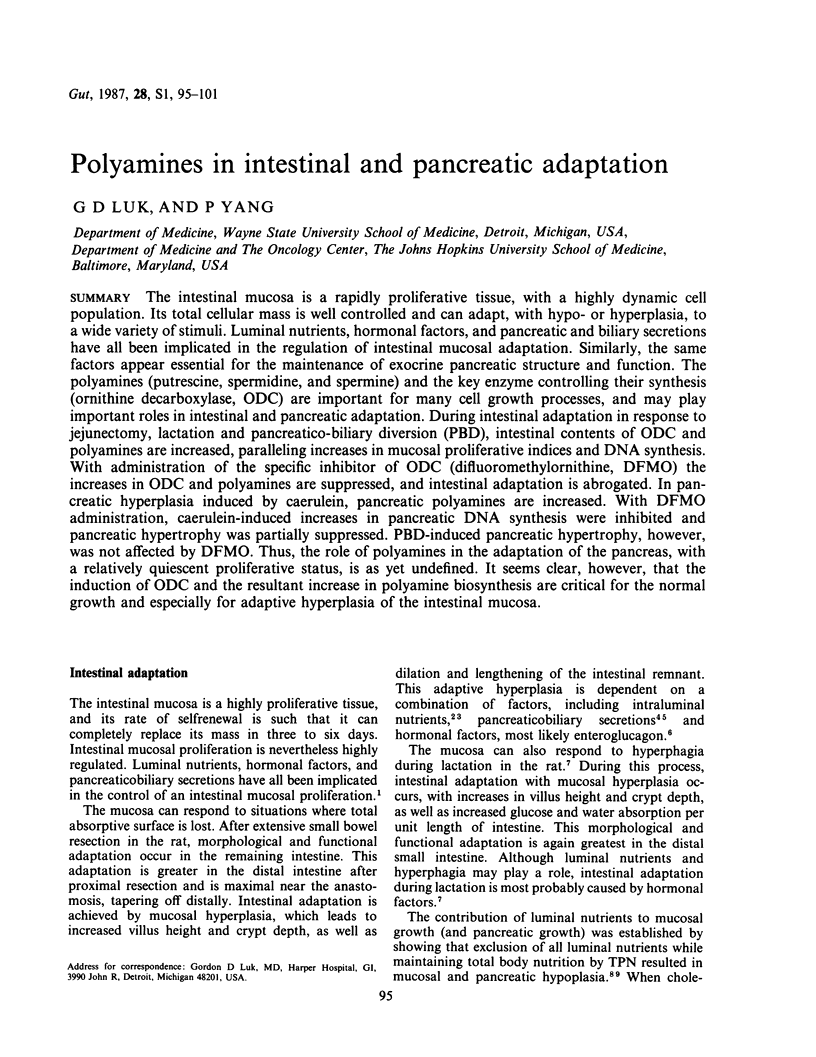
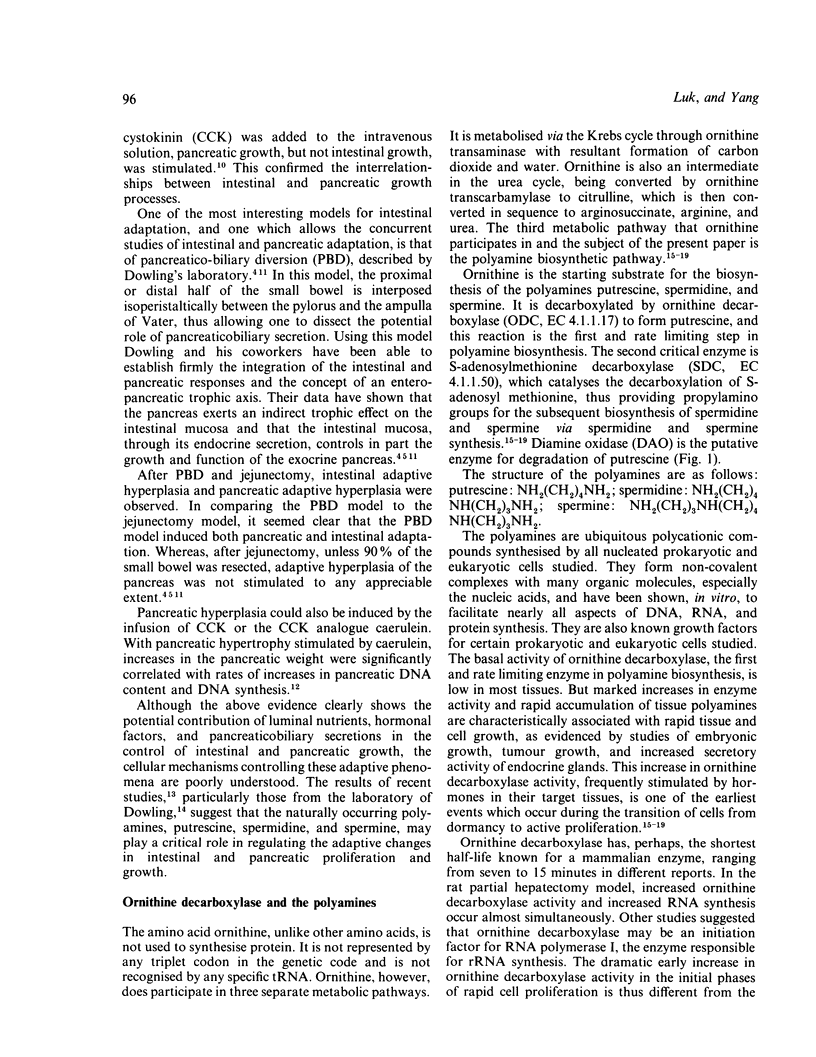
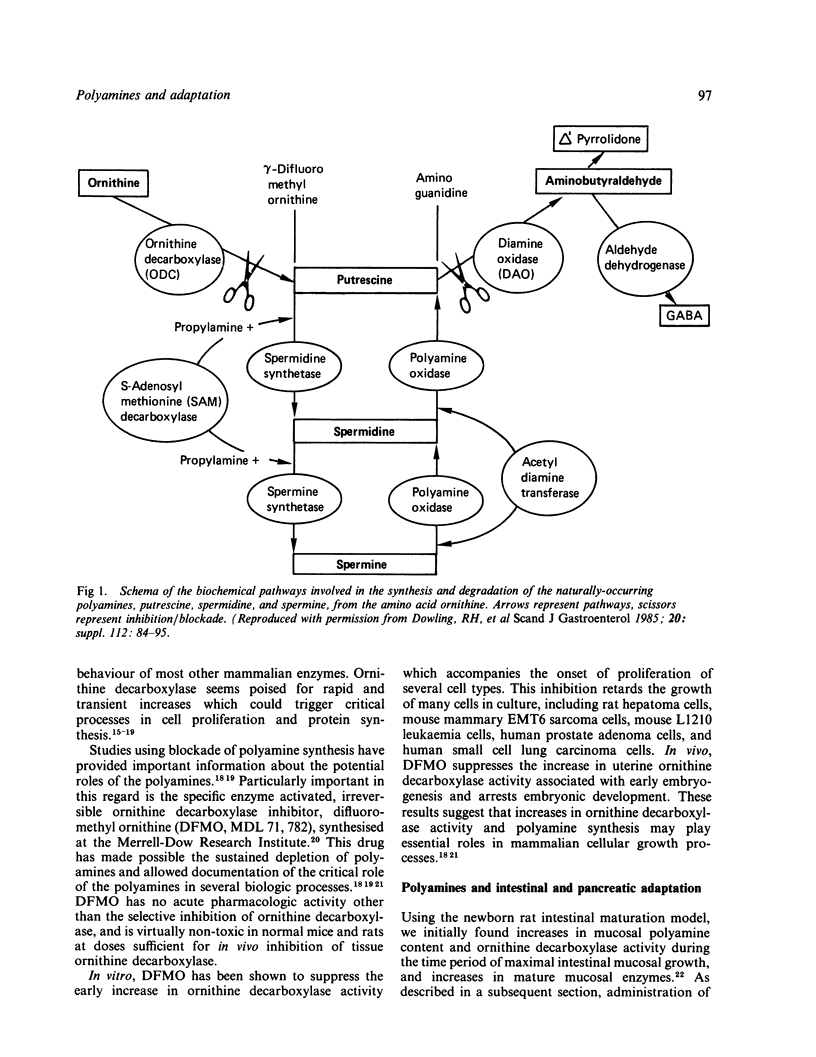
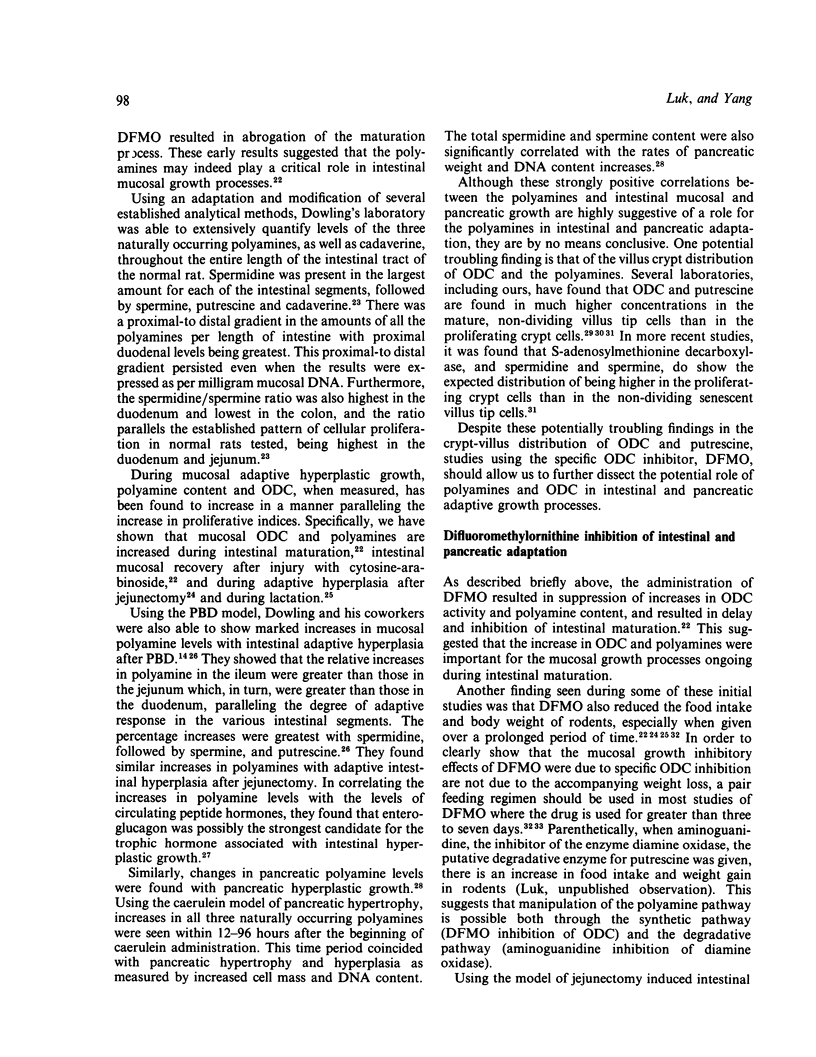
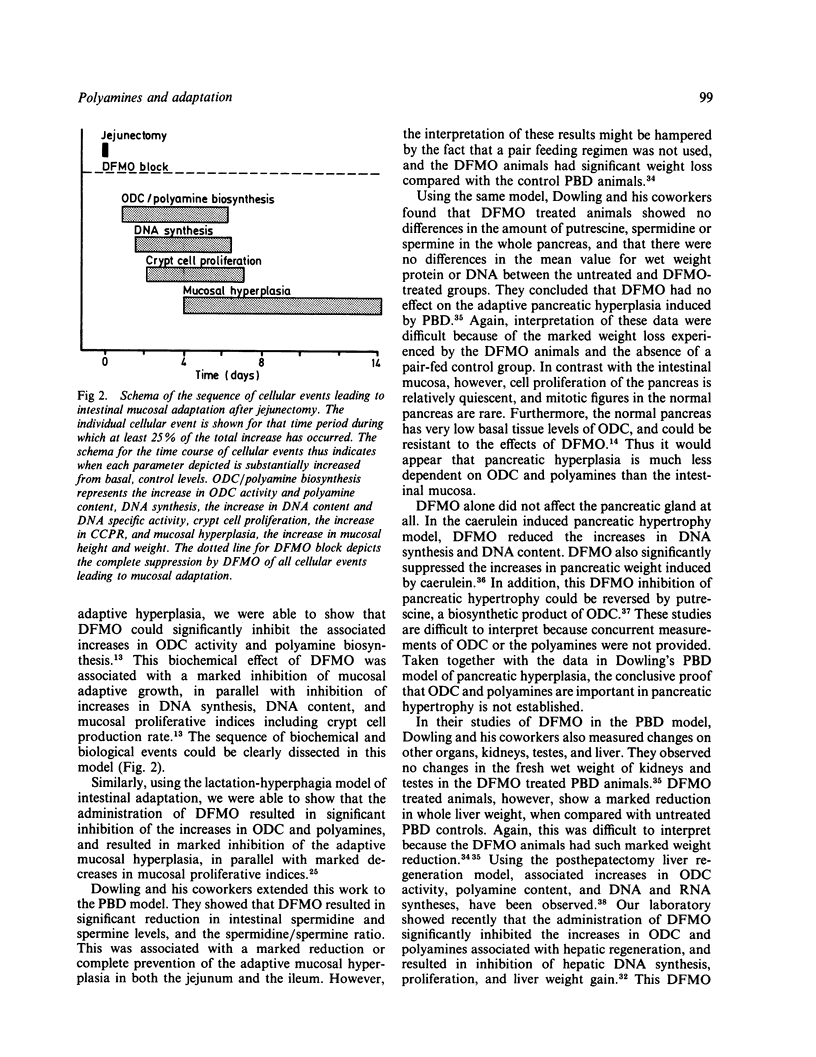

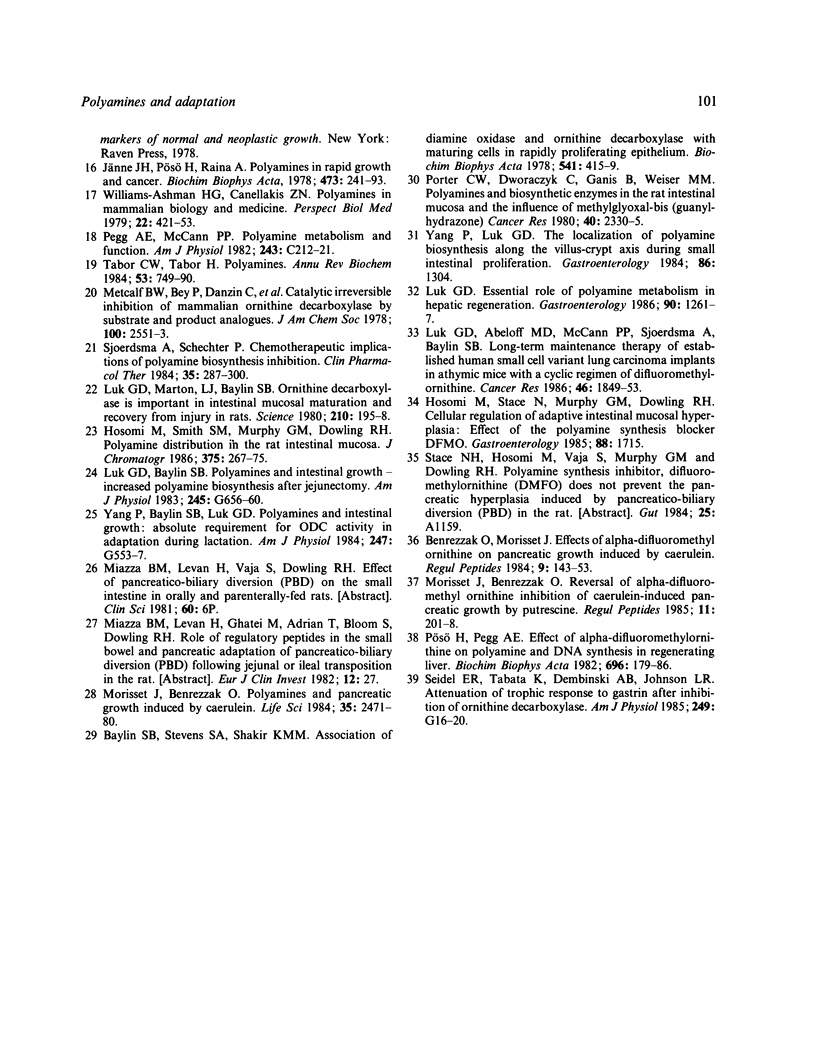
Selected References
These references are in PubMed. This may not be the complete list of references from this article.
- Baylin S. B., Stevens S. A., Shakir K. M. Association of diamine oxidase and ornithine decarboxylase with maturing cells in rapidly proliferating epithelium. Biochim Biophys Acta. 1978 Jul 3;541(3):415–419. doi: 10.1016/0304-4165(78)90200-3. [DOI] [PubMed] [Google Scholar]
- Benrezzak O., Morisset J. Effects of alpha-difluoromethylornithine on pancreatic growth induced by caerulein. Regul Pept. 1984 Oct;9(3):143–153. doi: 10.1016/0167-0115(84)90067-3. [DOI] [PubMed] [Google Scholar]
- Dowling R. H., Hosomi M., Stace N. H., Lirussi F., Miazza B., Levan H., Murphy G. M. Hormones and polyamines in intestinal and pancreatic adaptation. Scand J Gastroenterol Suppl. 1985;112:84–95. doi: 10.3109/00365528509092217. [DOI] [PubMed] [Google Scholar]
- Elias E., Dowling R. H. The mechanism for small-bowel adaptation in lactating rats. Clin Sci Mol Med. 1976 Nov;51(5):427–433. doi: 10.1042/cs0510427. [DOI] [PubMed] [Google Scholar]
- Fine H., Levine G. M., Shiau Y. F. Effects of cholecystokinin and secretin on intestinal structure and function. Am J Physiol. 1983 Sep;245(3):G358–G363. doi: 10.1152/ajpgi.1983.245.3.G358. [DOI] [PubMed] [Google Scholar]
- Hosomi M., Smith S. M., Murphy G. M., Dowling R. H. Polyamine distribution in the rat intestinal mucosa. J Chromatogr. 1986 Mar 7;375(2):267–275. doi: 10.1016/s0378-4347(00)83719-6. [DOI] [PubMed] [Google Scholar]
- Hughes C. A., Prince A., Dowling R. H. Speed of change in pancreatic mass and in intestinal bacteriology of parenterally fed rats. Clin Sci (Lond) 1980 Nov;59(5):329–336. doi: 10.1042/cs0590329. [DOI] [PubMed] [Google Scholar]
- Jänne J., Pösö H., Raina A. Polyamines in rapid growth and cancer. Biochim Biophys Acta. 1978 Apr 6;473(3-4):241–293. doi: 10.1016/0304-419x(78)90015-x. [DOI] [PubMed] [Google Scholar]
- Luk G. D., Abeloff M. D., McCann P. P., Sjoerdsma A., Baylin S. B. Long-term maintenance therapy of established human small cell variant lung carcinoma implants in athymic mice with a cyclic regimen of difluoromethylornithine. Cancer Res. 1986 Apr;46(4 Pt 1):1849–1853. [PubMed] [Google Scholar]
- Luk G. D., Baylin S. B. Inhibition of intestinal epithelial DNA synthesis and adaptive hyperplasia after jejunectomy in the rat by suppression of polyamine biosynthesis. J Clin Invest. 1984 Sep;74(3):698–704. doi: 10.1172/JCI111485. [DOI] [PMC free article] [PubMed] [Google Scholar]
- Luk G. D., Baylin S. B. Polyamines and intestinal growth--increased polyamine biosynthesis after jejunectomy. Am J Physiol. 1983 Nov;245(5 Pt 1):G656–G660. doi: 10.1152/ajpgi.1983.245.5.G656. [DOI] [PubMed] [Google Scholar]
- Luk G. D. Essential role of polyamine metabolism in hepatic regeneration. Inhibition of deoxyribonucleic acid and protein synthesis and tissue regeneration by difluoromethylornithine in the rat. Gastroenterology. 1986 May;90(5 Pt 1):1261–1267. doi: 10.1016/0016-5085(86)90394-x. [DOI] [PubMed] [Google Scholar]
- Lux G. D., Marton L. J., Baylin S. B. Ornithine decarboxylase is important in intestinal mucosal maturation and recovery from injury in rats. Science. 1980 Oct 10;210(4466):195–198. doi: 10.1126/science.6774420. [DOI] [PubMed] [Google Scholar]
- Miazza B. M., Turberg Y., Guillaume P., Hahne W., Chayvialle J. A., Loizeau E. Mechanism of pancreatic growth induced by pancreatico-biliary diversion in the rat. Inhibition by proglumide, benzotript, and ranitidine. Scand J Gastroenterol Suppl. 1985;112:75–83. doi: 10.3109/00365528509092216. [DOI] [PubMed] [Google Scholar]
- Morisset J., Benrezzak O. Polyamines and pancreatic growth induced by caerulein. Life Sci. 1984 Dec 10;35(24):2471–2480. doi: 10.1016/0024-3205(84)90456-9. [DOI] [PubMed] [Google Scholar]
- Morisset J., Benrezzak O. Reversal of alpha-difluoromethylornithine inhibition of caerulein-induced pancreatic growth by putrescine. Regul Pept. 1985 Jul;11(3):201–208. doi: 10.1016/0167-0115(85)90051-5. [DOI] [PubMed] [Google Scholar]
- Pegg A. E., McCann P. P. Polyamine metabolism and function. Am J Physiol. 1982 Nov;243(5):C212–C221. doi: 10.1152/ajpcell.1982.243.5.C212. [DOI] [PubMed] [Google Scholar]
- Porter C. W., Dworaczyk D., Ganis B., Weiser M. M. Polyamines and biosynthetic enzymes in the rat intestinal mucosa and the influence of methylglyoxal-bis(guanylhydrazone). Cancer Res. 1980 Jul;40(7):2330–2335. [PubMed] [Google Scholar]
- Pösö H., Pegg A. E. Effect of alpha-difluoromethylornithine on polyamine and DNA synthesis in regenerating rat liver: reversal of inhibition of DNA synthesis by putrescine. Biochim Biophys Acta. 1982 Feb 26;696(2):179–186. doi: 10.1016/0167-4781(82)90026-4. [DOI] [PubMed] [Google Scholar]
- Sjoerdsma A., Schechter P. J. Chemotherapeutic implications of polyamine biosynthesis inhibition. Clin Pharmacol Ther. 1984 Mar;35(3):287–300. doi: 10.1038/clpt.1984.33. [DOI] [PubMed] [Google Scholar]
- Solomon T. E., Vanier M., Morisset J. Cell site and time course of DNA synthesis in pancreas after caerulein and secretin. Am J Physiol. 1983 Jul;245(1):G99–105. doi: 10.1152/ajpgi.1983.245.1.G99. [DOI] [PubMed] [Google Scholar]
- Tabor C. W., Tabor H. Polyamines. Annu Rev Biochem. 1984;53:749–790. doi: 10.1146/annurev.bi.53.070184.003533. [DOI] [PubMed] [Google Scholar]
- Williams-Ashman H. G., Canellakis Z. N. Polyamines in mammalian biology and medicine. Perspect Biol Med. 1979 Spring;22(3):421–453. doi: 10.1353/pbm.1979.0013. [DOI] [PubMed] [Google Scholar]
- Williamson R. C. Intestinal adaptation (first of two parts). Structural, functional and cytokinetic changes. N Engl J Med. 1978 Jun 22;298(25):1393–1402. doi: 10.1056/NEJM197806222982505. [DOI] [PubMed] [Google Scholar]
- Yang P., Baylin S. B., Luk G. D. Polyamines and intestinal growth: absolute requirement for ODC activity in adaptation during lactation. Am J Physiol. 1984 Nov;247(5 Pt 1):G553–G557. doi: 10.1152/ajpgi.1984.247.5.G553. [DOI] [PubMed] [Google Scholar]


